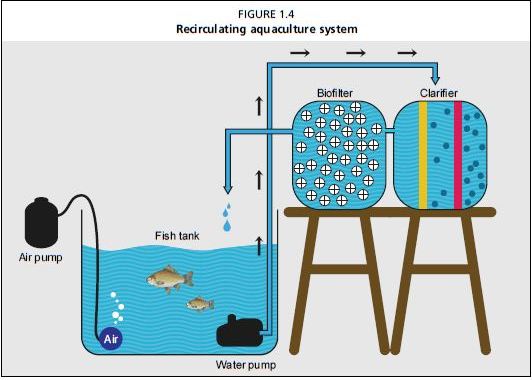1.2 AQUACULTURE
Aquaculture is the captive rearing and production of fish and other aquatic animal and plant species under controlled conditions. Many aquatic species have been cultured, especially fish, crustaceans and molluscs and aquatic plants and algae. Aquaculture production methods have been developed in various regions of the world, and have thus been adapted to the specific environmental and climatic conditions in those regions.
The four major categories of aquaculture include open water systems (e.g. cages, long- lines), pond culture, flow-through raceways and recirculating aquaculture systems (RAS). In a RAS (Figure 1.4) operation water is reused for the fish after a cleaning. and a filtering process. Although a RAS is not the cheapest production system owing to its higher investment, energy and management costs, it can considerably increase productivity per unit of land and is the most efficient water-saving technology in fish farming. A RAS is the most applicable method for the development of integrated aquaculture agriculture systems because of the possible use of by-products and the higher water nutrient concentrations for vegetable crop production. Aquaponics
FIGURE 1.4
Recirculating aquaculture system

has been developed from the beneficial buildup of nutrients occurring in RASs and, therefore, is the prime focus of this manual.
Aquaculture is an increasingly important source of global protein production. In fact, aquaculture accounts for almost one-half of the fish eaten in the world, with aquaculture production matching capture fisheries landings for the first time in 2012. Aquaculture has the potential to decrease the pressure on the world's fisheries and to significantly reduce the footprint of less-sustainable terrestrial animal farming systems in supplying humans with animal protein. However, two aspects of aquaculture may be addressed to improve the sustainability of this agricultural technique. One major problem for the sustainability of aquaculture is the treatment of nutrient-rich wastewater, which is a by-product of all the aquaculture methods mentioned above. Depending on the environmental regulations set by each country, farmers must either treat or dispose of the effluent, which can be both expensive and environmentally harmful. Without treatment, the release of nutrient-rich water can lead to eutrophication and hypoxia in the watershed and localized coastal areas, as well as macroalgae overgrowth of coral reefs and other ecological and economical disturbances. Growing plants within the effluent stream is one method of preventing its release into the environment and of obtaining additional economic benefits from crops growing with costless by-products through irrigation, artificial wetlands, and other techniques. Another sustainability concern is that aquaculture relies heavily on fishmeal as the primary fish feed. From a conservation standpoint, this is discharging one debt by incurring another, and alternative feed ingredients are an important consideration for the future of aquaculture. The majority of this publication is dedicated to reusing aquaculture effluent as a value- added product, while alternative fish feeds and their ways to contribute to reducing the aquaculture footprint are discussed in Section 9.1.2.